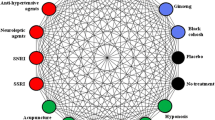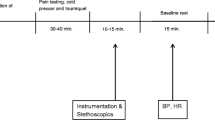Abstract
In the present study, we tested the effectiveness of a cognitive-behavioral group treatment (CBGT) for hot flashes in menopausal women. Treatment was administered over 8, 90 min weekly sessions and consisted of education, relaxation training and cognitive restructuring. Nineteen women meeting STRAW staging criteria for the menopause transition (stages −1 to +1) were randomly assigned to immediate or delayed treatment (wait list) and were asked to monitor their hot flashes and night sweats prospectively. They also completed questionnaires, including the Women’s Health Questionnaire and the Menopause Specific Quality of Life Questionnaire to determine psychosocial benefits of treatment. Results suggested that the CBGT was moderately successful in reducing the frequency of total vasomotor symptoms [F (1, 17) = 6.16, p < .01], as measured by daily symptom diaries. While there were arithmetic improvements in psychosocial functioning in this sample, these results were not significant. Despite the limitations of small sample size and possible placebo effect, this pilot study supports the notion that cognitive-behavioral interventions aimed at reducing vasomotor symptoms may be of value for menopausal hot flashes when administered in a small-group format.
Similar content being viewed by others
References
Adler, S. R., Fosket, J. R., Kagawa-Singer, M., McGraw, S., Wong-Kim, E., Gold, E., & Sternfeld, B. (2000). Conceptualizing menopause and midlife: Chinese American and Chinese women in the US. Maturitas, 35, 11–23
Anarte, M. T., Cuadros, J. L., & Herrera, J. (1998). Hormonal and psychological treatment: Therapeutic alternative for menopausal women? Maturitas, 29, 203–213
Bernhard, L., & Shappard, L. (1993). Health, symptoms, self-care, and dyadic adjustment in menopausal women. Journal of Obstetric Gynecology and Neonatal Nursing, 22, 456
Blanchard, E. B., and Schwarz, S. P. (1988). Clinically significant changes in behavioral medicine. Behavioral Assessment, 10, 171–188
Defey, D., Storch, E., Cardozo, S., Diaz, O., & Fernandez, G. (1996). The menopause: Women’s psychology and health care. Social Science and Medicine, 42(10), 1447–1456
Freedman, R. R., & Woodward, S. (1992). Behavioral treatment of menopausal hot flushes: Evaluation by ambulatory monitoring. American Journal of Obstetrics and Gynecology, 167, 436–439.r
Germaine, L. M., & Freedman, R. R. (1984). Behavioral treatment of menopausal hot flashes: Evaluation by objective methods. Journal of Consulting and Clinical Psychology, 52(6), 1072–1079
Hammar, M., Berg, C., & Lindgren, R. (1990). Does physical exercise influence the frequency of postmenopausal hot flushes? Acta Obstet Gynecol Scand, 69, 19/495/7/90
Harlow, S. D., Crawford, S. L., Sommer, B., & Greendale, G. A. (2000). Self-defined menopausal status in a multi-ethnic sample of midlife women. Maturitas, 36, 93–112
Hilditch, J. R., Lewis, J., Peter, A., vanMaris, B., Ross, A., Franssen, E., Guyatt, G., Norton, P. G., & Dunn, E. (1998). The menopause specific quality of life questionnaire: Development and psychometric properties. Maturitas, 24(3), 161–175
Hunter, M., & O’Dea, I. (1999). An evaluation of a health education intervention for mid-aged women: Five-year follow-up of effects upon knowledge, impact of menopause and health. Patient Education and Counseling, 37, 249–255
Hunter, M. S. (1992). The Women’s Health Questionnaire: A measure of mid-aged women’s perceptions of their emotional and physical health. Psychology and Health, 7, 45–54
Hunter, M. S. (1993). Predictors of menopausal symptoms: Psychosocial aspects. Bailliere’s Clin Endocrinol Metab, 7, 3345
Hunter, M. S., & Liao, K. L. M. (1996). Evaluation of a four session cognitive-behavioural intervention for menopausal hot flushes. British Journal of Health Psychology, 1, 113–125
Hunter, M. S. a. L., K.L.M. (1995). A psychological analysis of hot flushes. British Journal of Clinical Psychology, 34, 589–599
Irwin, J. H., Domar, A. D., Clark, C., Zuttermeister, P. C., & Friedman, R. (1996). The effects of relaxation response training on menopausal symptoms. Journal of Psychosomatic Obstetrics and Gynecology, 17(4), 202–7
Kroke, A., Schulz, M., Hoffman, K., Bergmann, M. M., & Boeing, H. (2001). Assignment to menopausal status and estimation of age at menopause for women with missing or invalid data– a probabilistic approach with weighting factors in a large-scale epidemiological study. Maturitas, 40, 39–46
Li, S., Holm, K., Gulanick, M., Lanuza, D., & Penckofer, S. (1999). The relationship between physical activity and perimenopause. Health Care for Women International, 20, 163–178
MacLennan, A., Lester, S., & Moore, V. (2003). Oral oestrogen replacement therapy versus placebo for hot flushes (Cochrane Review). In: The Cochrane Library, Issue 1. Oxford: Update Software
Montero, I., Ruiz, I., & Hernandez, I. (1993). Social functioning as a significant factor in women’s help-seeking behaviour during the climacteric period. Social Psychiatry and Psychiatric Epidemiology, 28, 178–183
Nixon, E., Kernoff-Mansfield, P., Kittell, L. A., & Faulkner, S. L. (2001). “Staying Strong”: How low-income rural African-American women manage their menopausal changes. Women and Health, 34(2), 81–95
O’Connor, V. M., Del-Mar, C. B., Sheehan, M., Siskind, V., Fox-Young, S., & Cragg, C. (1994). Do psychosocial factors contribute more to symptom reporting by middle-aged women than hormonal status? Maturitas, 20, 63–69
Reynolds, F. (1997). Psychological responses to menopausal hot flushes: Implications of a qualitative study for counselling interventions. Counselling Psychology Quarterly, 10(3), 309–321
Reynolds, F. (1999). Some relationships between perceived control and women’s reported coping strategies for menopausal hot flushes. Maturitas, 32, 25–32
Slade, P., & Amaee, S. (1995). The role of anxiety and temperature in the experience of menopausal hot flushes. Journal of Reproductive and Infant Psychology, 13, 127–134
Slaven, L., & Lee, C. (1997). Mood and symptom reporting among middle-aged women: The relationship between menopausal status, hormone replacement therapy and exercise participation. Health Psychology, 16(3), 203–208
Soules, M. R., Sherman, S., Parrott, E., Rebar, R., Santoro, N., Utian, W., & Woods, N. (2001). Executive Summary: Stages of Reproductive Aging Workshop (STRAW). Journal of Women’s Health and Gender-Based Medicine, 10, 843–848
Stearns, V., Beebe, K. L., Iyenger, M., & Dube, E. (2003). Paroxetine controlled release in the treatment of menopausal hot flashes: A randomized controlled trial. Journal of the American Medical Association, 289(21), 2827–34
Stevenson, D. W., & Delprato, D. J. (1983). Multiple component self-control program for menopausal hot flashes. Journal of Behavior Therapy and Experimental Psychology, 14(2), 137–140
Swartzman, L. C., Edelberg, R., & Kemmann, E. (1990). Impact of stress on objectively recorded menopausal hot flushes and on flush report bias. Health Psychology, 9(5), 529–545
Wijma, K., Melin, A., Nedstrand, E., & Hammar, M. (1997). Treatment of menopausal symptoms with applied relaxation: A pilot study. Journal of Behavior Therapy and Experimental Psychiatry, 28(4), 251–261
Wiklund, I., Karlberg, J., & Mattson, L. A. (1993). Quality of life of postmenopausal women on a regimen of transdermal estradiol therapy: A double-blind placebo-controlled study. American Journal of Obstetrics and Gynecology, 168, 824–830
Writing Group for the Women’s Health Initiative Investigators (2002). Risks and benefits of estrogen plus progestin in healthy postmenopausal women: Principal results from the women’s health initiative randomized controlled trial. Journal of the American Medical Association, 288, 321–33
Author information
Authors and Affiliations
Corresponding author
Rights and permissions
About this article
Cite this article
Keefer, L., Blanchard, E.B. A Behavioral Group Treatment Program for Menopausal Hot Flashes: Results of a Pilot Study. Appl Psychophysiol Biofeedback 30, 21–30 (2005). https://doi.org/10.1007/s10484-005-2171-1
Issue Date:
DOI: https://doi.org/10.1007/s10484-005-2171-1




